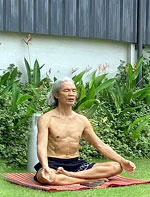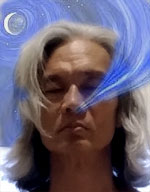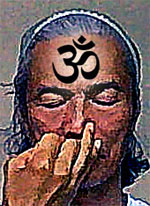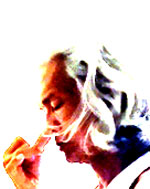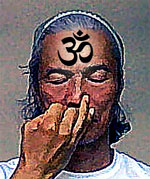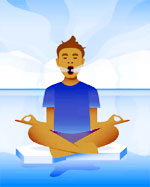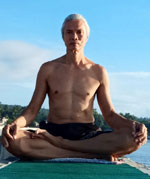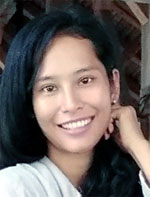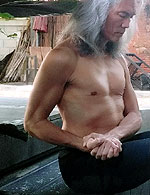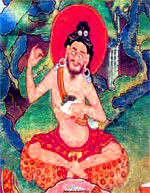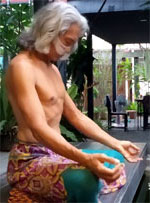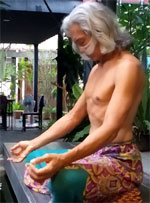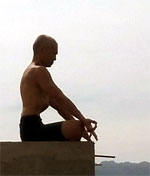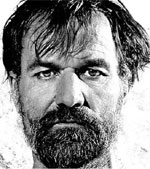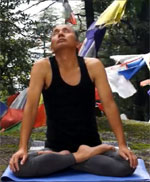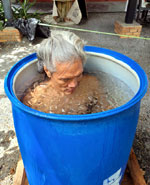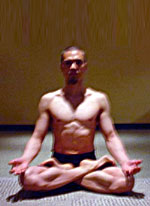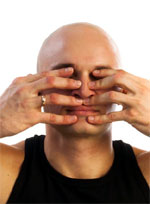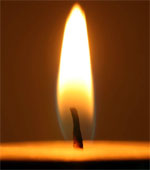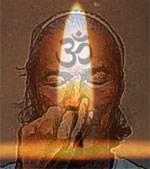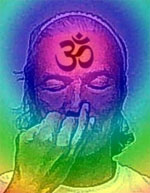
Pranayama Classes
Pranayama Yoga Series
Basic Pranayama Classes (breath regulation)
Intermediate-Advanced Pranayama
8 Limbs of Yoga
8 Limbs of Yoga
What are they?
The practice of yoga has begun since time immemorial in India. But it was an oral tradition that was passed on from teacher to student. The sage Patangali, in an attempt to simplify yoga, codified the practice in what is now called the Yoga Sutras. In the sutras, he segmented yoga into 8 parts called the 8 Limbs of Yoga. The 8 limbs are supposed to be practiced in overlapping linear sequence - from moral grounding to ascencion.
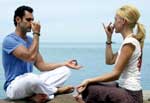 Oct 24, 2016
Oct 24, 2016
Pranayama: An Introduction
(updated Feb 2020 with T. Krishnamacharya's Yoga Makaranda II)
Disclaimer
While I have completed my 200 hours of teacher-training and have been practicing yoga for over 2 decades, I am not a guru and I don't package myself as one. I'm just a dedicated practitioner sharing my knowledge, skill, and insight.
This sequence is an advanced hack on yoga - some are not in the books and it's risky especially if your practice is not strong. Ideally, you should be under the guidance of a guru or be initiated into the practice. I'm doing this on my own because I cannot find a suitable guru and I am comfortable studying established yoga books and weaving different practices into a seamless singularity (like a chef who creates an intuitive fusion-recipe with everything he knows about cooking). The fact that I'm posting this means I have already done it many times with only positive results. My unique practice has made me strong, vibrant and resilient from disease. Be advised that if you do this sequence, you are doing it at your own risk.
Glossary
- prana - the life energy that permeates our universe. Other cultures call it 'chi' or 'qi'. Without prana, there is no life.
- pranayama - in yoga, it is the exercise of regulating the breath - the inhalation, exhalation and the breath-holds. Breathing should always be long and thin
- kumbhaka - a type of pranayama where you hold the breath - either on the inhale (antara kumbhaka) or on the exhale (bahya kumbhaka). At the advanced level, it's a spontaneous cessation of the breath (kevala kumbhaka)
- asana - the physical yoga pose
- nadi - these are the energy channels within the psychic body, responsible for energy (prana) distribution. There are 72,000 nadies within the body. Analogy - an intricate road system within a city
- surya - sun, masculine, high energy, right nostril breathing
- chandra - moon, feminine, recovery and healing, left nostril breathing
- bhedan - penetration
- bhastrika - bellows
Human Shelf life
In the Indian culture, the longevity of a human life is predetermined by the number of breaths taken in a lifetime - not the number of years (e.g. - a boy is born with a pre-ordained 2 million breaths. If he uses up those 2 million breaths in 30 years, his life will end at age 30). This is a powerful statement because it means you can extend your life by regulating the breath (if this boy slows down his breathing or holds it between inhalation and exhalation to a point he uses up 2 million breaths in 31 years, then he extends his life by 1 year).
Nadis
Nadis are energy channels within our psychic body. Like capillaries, they form an intricate matrix (or road system) throughout the body for energy distribution. It is said there are 72,000 nadis in the human body, converging on the jivatma (heart) (or kandasthana, or muladhara chakra, depending on which text you read). Prana is distributed in our system through the nadis. If the nadis are blocked, prana cannot flow through - that is when sickness occurs. Example - if the nadis in our kidneys are blocked, prana or the life energy cannot enter our kidney. We begin to suffer kidney failure or kidney disease in the process. Through pranayama, asana, and shatkriya (purification process) we clear the blockages in the nadis and allow the free-flow of prana and this restores the body back to health.
Prana
Contrary to popular belief, prana is NOT just in the air we breathe. It is pervasive in the universe, without which, the universe itself cannot exist. Our prana is what keeps us alive. Prana governs all the actions of our faculties. Prana is a sheath around the body, extending to 12 inches outside the physical body. We are able to control prana through our breathing. The more we breathe, the more we use up prana. The less we breathe, like while being in a meditative state, the more we conserve our prana and thus extend our life. Pranayama should be done at least 4 hours after the last meal.
Every individual is born with a finite quantity of prana - you cannot increase it but you can exercise prana to make it stronger - same way we exercise our muscles by lifting weights.
Superman Effect
Breathing sounds so simple it's almost dismissive - we breathe day-in and day-out, so what's special about it? Out of curiosity back in Feb 2008, I toyed with pranayama as I was reading a Sivananda Yoga book. After doing it for half a day, I experienced what I would call the superman-effect. It gave me a first-hand account of just how powerful this technique is. Since that epiphany, pranayama has always been a part of my yoga practice. I follow my asanas with pranayama then meditation. I feel that those three in combination provide a synergistic effect that asana alone cannot deliver. I also integrate such combination whenever I conduct a yoga class, even abbreviating the asana portion just to accommodate the pranayama and meditation within a one hour session.
Caution
Pranayama is a double-edged sword and thus need to be done with caution or done with someone who understands pranayama. I would liken it to fire. If you know what you are doing, the fire can cook your food. If you don't know what you're doing, it will burn your house down...and even burn you. Doing pranayama is dealing with something volatile - you'd been warned!

Simon Borg-Olivier doing pranayama
Bandhas During Pranayama
Mula Bandha is engaged at all times during Pranayama. Jalandhara Bandha is engaged beginning on the Antara kumbhaka (in-breath hold) and sustained until the end of the pranayama. Uddiyana Bandha begins after the exhale when the lungs are empty. So during the breathing, the bandhas are engaged in this order: Mula on the inhale, Mula + Jalandhara on the inbreath-hold, Mula + Jalandhara + Uddiyana bandha on the outbreath-hold. Release all bandhas before the inhale.
Kumbhaka During Pranayama
Kumbhaka during Pranayama is a breath-hold. It can be done with or without bandhas. Initially, equal time is enough during inbreath-hold-outbreath. No need to hold the outbreath. With proficiency, you can cautiously include the outbreath on an equal ratio. In the advanced stages of pranayama, several ratios can be exercised. I use the 1:4:2:3 ratio with full bandhas using a metronome as my timer. Absolutely no straining on the breath-hold. If you gasp for the next breath, then you held it too long.
Disclaimer
While I have completed my 200 hours of teacher-training and have been practicing yoga for over 2 decades, I am not a guru and I don't package myself as one. I'm just a dedicated practitioner sharing my knowledge, skill, and insight.
This sequence is an advanced hack on yoga - some are not in the books and it's risky especially if your practice is not strong. Ideally, you should be under the guidance of a guru or be initiated into the practice. I'm doing this on my own because I cannot find a suitable guru and I am comfortable studying established yoga books and weaving different practices into a seamless singularity (like a chef who creates an intuitive fusion-recipe with everything he knows about cooking). The fact that I'm posting this means I have already done it many times with only positive results. My unique practice has made me strong, vibrant and resilient from disease. Be advised that if you do this sequence, you are doing it at your own risk.
Benefits of Pranayama:
- Purification of nadis - all 72,000 nadis are purified
- Control of mind - it's hard to control the mind - it is inherently volatile. But there is a domino-effect that can be used to control the mind. Control the breath through Pranayama and you control Prana. Where prana goes, the mind goes there as well. So, by controlling the breath through Pranayama, you control the mind
- Prana flows along Sushumna - during regular breathing, prana loops along Ida and Pingala. But during a breath-hold (kumbhaka), prana flows along Sushumna Nadi
- Nerve impulses are suspended - breath-hold suspends nerve impulses causing equanimity in the brain functions
- -
- -
Pranayama
Ideally, pranayama should only be done when you have gained proficiency in yama, niyama and asana - there is a reason why yoga is characterized by 8 progressive limbs. A base limb is always a preparation for the next limb - it's a foundation. If pranayama is done seated, Siddhasana and Padmasana are best (when done right, I find Siddhasana more challenging and more powerful than Padmasana). Ensure you are seated comfortably with sit bones centered and a straight back. The ideal breathing is slow, thin, deep and rubs the throat (Ujjayi breathing). Only nose breathing unless specified otherwise. Do this on an empty stomach. When closing the nostrils, best to use Mrigi Mudra (there should be a slight pull on the nose when both nostrils are closed. The face and eyes should feel that slight pull).
- Surya Bhedan (Suryabhedana) (right inhale, left exhale)
Method: engage Mula Bandha (at all times), then very slow and thin breathing on the right nostril only. When fully inflated, hold breath for Jalandhara Bandha. Exhale very slowly on the left nostril and empty the lungs. Engage Uddiyana Bandha. personal note - also according to Krishnamacharya, for thin people (me!), Uddiyana Bandha can be done after the in-breath. This is what I'm doing - Uddiyana Bandha on the Antara Kumbhaka and not on the Bhaya Kumbhaka
Effect: activates the sympathetic nervous system - fight or flight for energy surge
Benefits: increases energy levels and makes you full of life
For Whom: for people who are down, lethargic or suffering from depression
Note: master this first before any other pranayama to take full benefit of other pranayamas
Chandra Bhedan (left inhale, right exhale)
Method: same as Surya Bhedan but reversed nostrils.
Effect: activates the para-sympathetic nervous system - recovery, relaxation and healing
Benefits: slows down the energy flow, relaxes the mind and calms the body
For Whom: for people who are stressed and agitated. For people who want to fall asleep (for insomniacs) -
Ujjayi (breathing-in is done through both nostrils with a rubbing sensation along the throat)
Method: long, thin, deep and steady breathing that rubs behind the throat and produces an audible hissing sound. Ujjayi is one of the major breating methods in Pranayam.
Benefits: reduces stress and calms mind.
For Whom: for everyone
Ujjayi Pranayama video (10 mins)
Ujjayi Anuloma (breathing-in is done through both nostrils, and breathing out through alternate nostrils)
Method: long, thin, deep and steady breathing that rubs behind the throat and produces an audible hissing sound
Benefits: reduces stress and calms mind
For Whom: for everyone
Ujjayi Viloma (breathing-in is done through alternate nostrils, and breathing out through both nostrils)
Method: long, thin, deep and steady breathing that rubs behind the throat and produces an audible hissing sound
Benefits: phlegm is brought out, and this should be spit out
For Whom: for everyone
Pratiloma Ujjayi (inhale throat-exhale right-inhale right-exhale throat, inhale throat-exhale left-inhale left-exhale throat >> this is one round )
Method: long, thin, deep and steady breathing that rubs behind the throat and produces an audible hissing sound
Benefits: cleans up all the air passages and air vessels, cures coughing and sneezing, stops habit of mouth-breathing.
For Whom: for everyone
- Nadi Shodhana (Nadisodana) (alternate nose breathing - other texts say this is the same as Lom Anulom Vilom. The translation is "nadi cleansing" so this is a good breathing exercise to unblock the nadis and pave way for the passage of prana). This pranayama is so powerful that it is included as one of the 6 Shatkriyas in purifying the system.
Method: long and thin breathing. Cover the right nostril and breathe-in to the left. Hold as long as you can. Close the left nostril and exhale slowly on the right nostril. Hold as long as you can. Breathe-in to the right nostril. Hold as long as you can. Exhale slowly on the left nostril. Hold as long as you can. Repeat for 5 minutes.
Effect: clears the energy channels
Benefits: purifies the blood and respiratory system, balances left and right brain
For Whom: for everyone
Variations
Lom Anulom Vilom (alternate nose breathing w/o the breath hold)
Method: cover the right nostril and breathe-in to the left. Short pause. Close the left nostril and exhale slowly on the right nostril. Short pause. Breathe-in to the right nostril. Short pause. Exhale slowly on the left nostril. Short pause. Repeat for 5 minutes.
Benefits: balances the energy levels in the body and mind
For Whom: for everyone - Shitali (Sitali) (rolled tongue between teeth inhale)
Method: it is ideal if Shitali is preceded by either Kapalbhati or Bhramari. Mouth inhale while tongue is rolled lengthwise, holding the breath with a chin-tuck (Jalandhara bandha) with tongue on the nostril cavity (Nabho mudra) and exhaling to the nose
Benefits: cools the body, cures stuttering
For Whom: for people who are sweating a lot and need to cool down - Shitkari (Shitkari) (tongue between teeth inhale)
Method: mouth inhale while tongue is lightly pressed between teeth, and exhaling to the nose
Benefits: lowers body temperature
For Whom: for people who need to cool down due to hot temperature - Bhramari (bee sound)
In these Covid times (Jun 2021), it has been known that the virus attacks the respiratory system. At the same time, it has been rediscovered that among the many types of pranayama, there is one that proves very effective in combating Covid - Bhramari. Bhramari activates nitric oxide, a vasodilator that relaxes the inner lining of the blood vessles, allowing them to widen and carry more oxygen in the blood - as much as a whopping 20% more oxygen. This nitric oxide is also responsible for stopping the replication of viruses and pathogens. So, in these Covid times, let's default to Bharami.
Oddly, in YM2, Bhramari together with Lahari and Murcha, are omitted because they only provide short-term physical benefits - nothing more.
Method: thumbs on the ears and the rest of the fingers covering the eyes, inhale to the nose and make a bee humming sound on a very slow exhale. Keeping in mind that key to this pranayama is to resonate with the vibrational frequency of the bee sound. Imagine the gross apparent solidity of your body to be the walls of Jericho - crumbling down. The solidity dissolves until you only feel a mass of vibrations vibrating in unison with the sound of Bhramari...until you and the sound are inseparable and indistinguishable.
Benefits: clears the mind and improves hearing, instantly calms the mind down
For Whom: for people who are agitated and irritated, reduces blood pressure - LAHARI or PLAVINI
Oddly, in YM2, Bhramari together with Lahari and Murcha, are omitted because they only provide short-term physical benefits - nothing more.
Method: inhale fully and begin swallowing air into the stomach (like 'packing' when you go freediving).
Benefits:
For Whom: - Kapalabhati
(forceful exhalation using the belly, aka skull shining)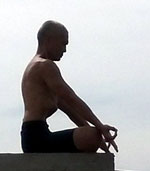 When Surya Bhedan has already been mastered (this should be the first pranayama learned), it is best to start a pranayama session with either Kapalbhati or Bhastrika. Kapalabhati comes from the words kapal meaning head and bhati meaning pressure - head pressure. By doing this pranayama, the mind is cleared of its cobwebs. Clarity of thinking is amplified. Impure energy and toxins in the head are released.
When Surya Bhedan has already been mastered (this should be the first pranayama learned), it is best to start a pranayama session with either Kapalbhati or Bhastrika. Kapalabhati comes from the words kapal meaning head and bhati meaning pressure - head pressure. By doing this pranayama, the mind is cleared of its cobwebs. Clarity of thinking is amplified. Impure energy and toxins in the head are released.
Method: forceful and rapid exhalation by contracting the abdomen
Benefits: weight loss, strengthens the body by forcing more prana into the system
For Whom: for people who want to lose weight, fortify their body, making it resistant to disease
- Bhastrika (rapid and forceful inhalation and exhalation on both nostrils)
Method: rapid and forceful inhalation and exhalation on both nostrils
Benefits: energizes the body and boosts memory power
For Whom: for everyone
Variations
Surya Bhastrika (rapid and forceful inhalation and exhalation on the right nostril - other texts would have it as a right nostril inhalation but left nostril exhalation)
Method: close the left nostril then rapid and forceful inhalation and exhalation on the right nostril. Sustain without straining. Last inhalation, hold the breath and chin tuck for as long as you can. Then tilt the head up and resume normal breath.
Benefits: fills up with energy and vitality
For Whom: for people who need to be energized, for people who are sad, forlorn and feeling down
Chandra Bhastrika (rapid and forceful inhalation and exhalation on the left nostril - other texts would have it as a left nostril inhalation but right nostril exhalation)
Method: close the right nostril then rapid and forceful inhalation and exhalation on the left nostril. Sustain without straining. Last inhalation, hold the breath and chin tuck for as long as you can. Then tilt the head up and resume normal breath.
Benefits: calms the mind and relaxes the body
For Whom: helps people go to sleep and calm down
Surya Chandra Bhastrika (alternate rapid and forceful inhalation and exhalation)
Method: close the right nostril then rapid and forceful inhalation on the left nostril. Close the left nostril followed by rapid and forceful exhalation then inhalation on the right nostril. Close the right nostril followed by rapid and forceful exhalation then inhalation on the left nostril. Repeat for 5 minutes. Last inhalation, hold the breath and chin tuck for as long as you can. Then tilt the head up and resume normal breath.
Benefits: balances and energizes the body and mind
For Whom: for everyone - Murcha (retain breath until you feel a fainting feeling. Best result is doing 30 Wim Hof breaths and then retain the last inbreath - you feel the 'high')
Method: full inhale on nabho mudra, tilting the head back into sambhavi mudra. When fully inhaled, gently take the head upright and down into jalandara bandha. Hold. This is more a kumbhaka/mudra exercise and not so much about breathing
Benefits: gives glow to skin, increases stamina, reduces stress
For Whom: for people who want good skin
Ending Thoughts
I find it fascinating that this reservoir of immense power is free and readily accessible. But I remain baffled that people still subscribe to medication and pills to find artificial strength and vigor. My gratitude to the ancients for preserving this powerful technique and sharing it to the free world at large. Who would have thought that the mundane breathing, when properly executed and regulated, could be so powerful? Pranayama is perhaps the most under-rated wellness practice on the planet (although pranayama goes waaaay beyond wellness).
--- Gigit (TheLoneRider)
YOGA by Gigit ![]() |
Learn English
|
Learn English ![]() |
Travel like a Nomad
|
Travel like a Nomad ![]() |
Donation Bank
|
Donation Bank ![]()
ps - If you want me to participate and write about your yoga studio or your yoga practice, email me. For my complete yoga profile, you can visit this page: YOGA by Gigit
Leave a comment?
Reader Comments:
 Rosel
Rosel Theosophical Society - Philippines
(Oct 24, 2016) The article warns of the dangers of the misuse of pranayama. It suggests the need for guidance. The focus of yoga is enlightenment, not the physical body. We should not lose sight of that. A friend of mine became afflicted with heart disease after wrongful application of pranayama. Yet those who know,!use it to insulate consciousness from the vibrations of the outside world in the pursuit of higher yoga. Shanti.
(Oct 18, 2023) Agreed! That's why I underscored a "Caution" paragraph to warn of the inherent danger. No argument that yoga is designed for enlightenment. But I see no harm in using yoga to fortify the body - afterall, the body is the divine manifestation in gross physical form. With a strong body, we can deepen yoga from a position of strength. Namaste 🙏
Blogs about Prana and Pranayama
- Pranayama Basics II Jun 16, 2021
- Pranayama Basics I Jun 9, 2021
- Learning How to Breathe Jun 2, 2021
- Pranayama Primer Feb 2, 2021
- Prana Vayu Adhitthana Yoga Class July 11-12, 2020
- Covid 19 and Pranayama Mar 20, 2020
- Prasnopanishad: Understanding Prana Jan 17, 2020
- Prana Mudra Sep 21, 2019
- Prana Vayu (Pranic Wind) Sep 20, 2019
- Pranayama in Moalboal, Cebu Aug 3, 2017
- Pranayama: An Introduction Oct 24, 2016
- Pranayama in Sagada: the Superman-Effect Jan 30, 2008
Yoga-Sequence Series
- Pranayama Sequence Oct 24, 2016
- Tibetan 5 Rites Mar 28, 2016
- Meditation Basics Nov 7, 2015
- Handstand Clinic at Surya Nanda Yoga Studio Aug 23, 2015
- Power Yoga Class - Singapore Mar 21,2015
- Adhitthana Yoga (Yoga of Strong Determination) Sept 4, 2014
- Twist Sequence Jun 28, 2014
- One-Leg Sequence (balancing) Jun 14, 2014
- Core Sequence Jun 7, 2014
- Backbend Sequence May 31, 2014
»» next Yoga story: Davao Yoga Scene
»» back to Yoga
»» back to Homepage
ARCHIVE 2025:
JAN |
FEB |
MAR
1970 |
1973 |
1975 |
1976 |
1979 |
1981 |
1996 |
2000 |
2001 |
2002 |
2003 |
2004 |
2005 |
2006 |
2007 |
2008 |
2009 |
2010 |
2011 |
2012 |
2013 |
2014 |
2015 |
2016 |
2017 |
2018 |
2019 |
2020 |
2021 |
2022 |
2023 |
2024 |
2025 |
ALL BLOGS

